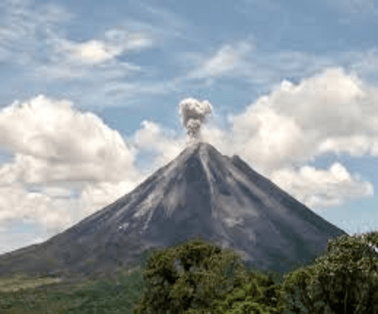Mount Etna, the largest volcano in Europe, and among the world’s most active and iconic volcanoes, has been sending up almost perfect rings of smoke into the air. The rings are a rare phenomenon that scientists refer to as volcanic vortex rings
What Are Volcanic Vortex Rings?
- Vortex rings are generated when gas, predominantly water vapour, is released rapidly through a vent in the crater.
- The vent that has opened up in Etna’s crater is almost perfectly circular, so the rings that have been seen above the mountain are also circular.
- The phenomenon was first observed at Etna and Vesuvius in Italy in 1724, and has been documented in an engraved plate from 1755.
- In more recent times, volcanic vortex rings have been observed at volcanoes such as Redoubt in Alaska, Tungurahua in Ecuador, Pacaya in Guatemala, Eyjafjallajökull and Hekla in Iceland, Stromboli in Italy, Aso and Sakurajima in Japan, Yasur in Vanuatu, Whakaari in New Zealand, and Momotombo in Nicaragua. (‘Dynamics of Volcanic Vortex Rings’: Scollo et al., Scientific Reports)
- The rings can remain in the air for up to 10 minutes, but tend to disintegrate quickly if conditions are windy and turbulent.
A Closer Look at Mount Etna
- Mount Etna, sometimes referred to simply as Etna, is an active volcano on the east coast of Sicily, the largest island in the Mediterranean Sea
- Etna’s peak is the highest in Italy south of the Alps, and it is Europe’s largest and one of the most active volcanoes.
- Mount Etna is a stratovolcano, which means it is composed of layers of lava, ash, and rocks that have accumulated over thousands of years of eruptions.
- Etna’s summit has five craters, which are responsible for most of the volcano’s eruptions; there are also “flank” eruptions that occur out of 300-odd vents of varying sizes along the slopes of the mountain.
- Etna is in almost constant activity, and has seen, since the year 1600, at least 60 flank eruptions and many more summit eruptions.
- Etna has been a World Heritage Site since 2013, and according to UNESCO, the volcano’s eruptive history can be traced back 500,000 years. At least 2,700 years of this activity has been documented.
Volcanoes Across the World
- One of the most famous long-term eruptions was Kilauea volcano on Hawaii.
- Its spewing spree in 1983 continued — almost nonstop — for 35 years until 2018, only to start again in 2021. The eruption is still ongoing.
- Dukono in Indonesia started erupting in August 1933 and is still continuing.
- Santa Maria in Guatemala began erupting in June 1922 and continues to this day.
- Yasur in Vanuatu first rumbled to life in about 1270 (± 110 years) and as of June 2023, was still erupting
What Are Volcanoes?
- Volcanoes are geological features characterized by openings or vents through which lava, tephra (small rocks), and steam erupt onto the Earth’s surface.
- They result from both their own eruptions and the broader processes of tectonic plate movement.
- Volcanic eruptions are essentially the result of magma, or molten rock, beneath the Earth’s surface rising, bubbling, and ultimately overflowing, much like boiling milk spilling out of a pot on a stove.
- The magma seeks pathways to vents within the volcano, where it erupts and is expelled across the land and into the atmosphere, a phenomenon referred to as lava.
- Scientific evidences also show their presence in other planets like Mars and Venus
Different Types Of Volcanoes
- Shield Volcanoes – They form very large, gently sloped volcanoes with a wide base. Example: Mauna Loa in Hawaii.
- Cinder cones – They are the smallest volcanic landform, formed from accumulation of many small fragments of ejected material.
- Composite Volcanoes (Stratovolcanoes) – They are characterised by eruptions of cooler and more viscous lavas than basalt and have steep sides and are more cone-shaped than shield volcanoes.
- Caldera – These are the most explosive of the earth’s volcanoes. When they erupt, they collapse on themselves rather than building and this collapsed depressions are called calderas.
- Flood Basalt Provinces – They outpour highly fluid lava that flows for long distances. Example: The Deccan Traps from India.
- Mid-Ocean Ridge Volcanoes – They occur in the oceanic areas where the central portion of this ridge experiences frequent eruptions.
- Active volcano – It is called so if the materials mentioned are being released or have been released out in the recent past.
Distribution of Volcanoes Around the World
- There are about 500 volcanoes in the world. Most of these volcanoes are found in three well defined belts.
- The Circum-Pacific Belt: Circum-Pacific region has the greatest concentration of volcanoes, that is why it is called ‘Pacific Ring of Fire‘. It is a horseshoe-shaped zone encircling the Pacific Ocean. This ring extends along the Andes mountains of South America to Alaska and from the Aleutian Islands to Japan, Philippines, Indonesia to New Zealand. Major Volcanoes: Mount St. Helena, Mauna Loa,Mount Ruapehu, Mount Krakatoa, Mount Fuji.
- The Mid-World Mountain Belt: The Mid-world mountain belt occupies the second position with regard to the numbers of volcanoes. It runs from Alps in Europe to Asia Minor and crossing through Himalayan region joins the Circum-Pacific belt Major Volcanoes Stromboli , Mt. Vesuvius , Mt. Karakoram. India’s only active volcano is located in Barren island of Andaman, which is also the only confirmed active volcano in South Asia
- The African Rift Valley Belt: The African Rift Valley region ranks third. Most of the volcanoes are extinct here. Cameroon is the only active volcano which is situated in Central West Africa
Conclusion
Volcanoes like Mount Etna showcase the Earth’s raw power and constant transformation. From rare vortex rings to ongoing eruptions across the world, studying volcanoes helps us better understand our planet’s inner workings and prepare for natural hazards. Their global presence makes them both a scientific curiosity and a crucial part of Earth’s dynamic system.
To Download Monthly Current Affairs PDF Click here
Click here to get a free demo
Discover all about CLAT Exam



